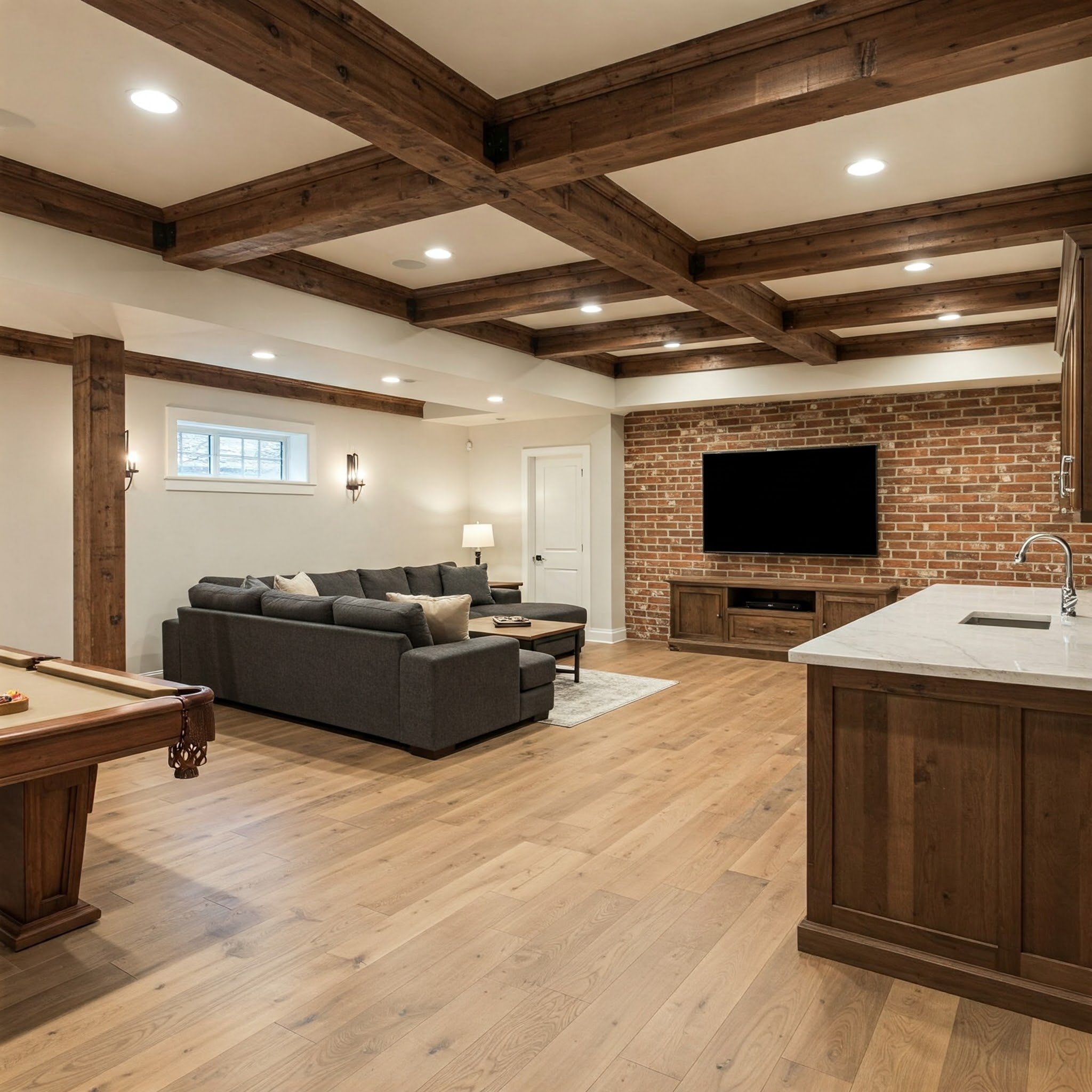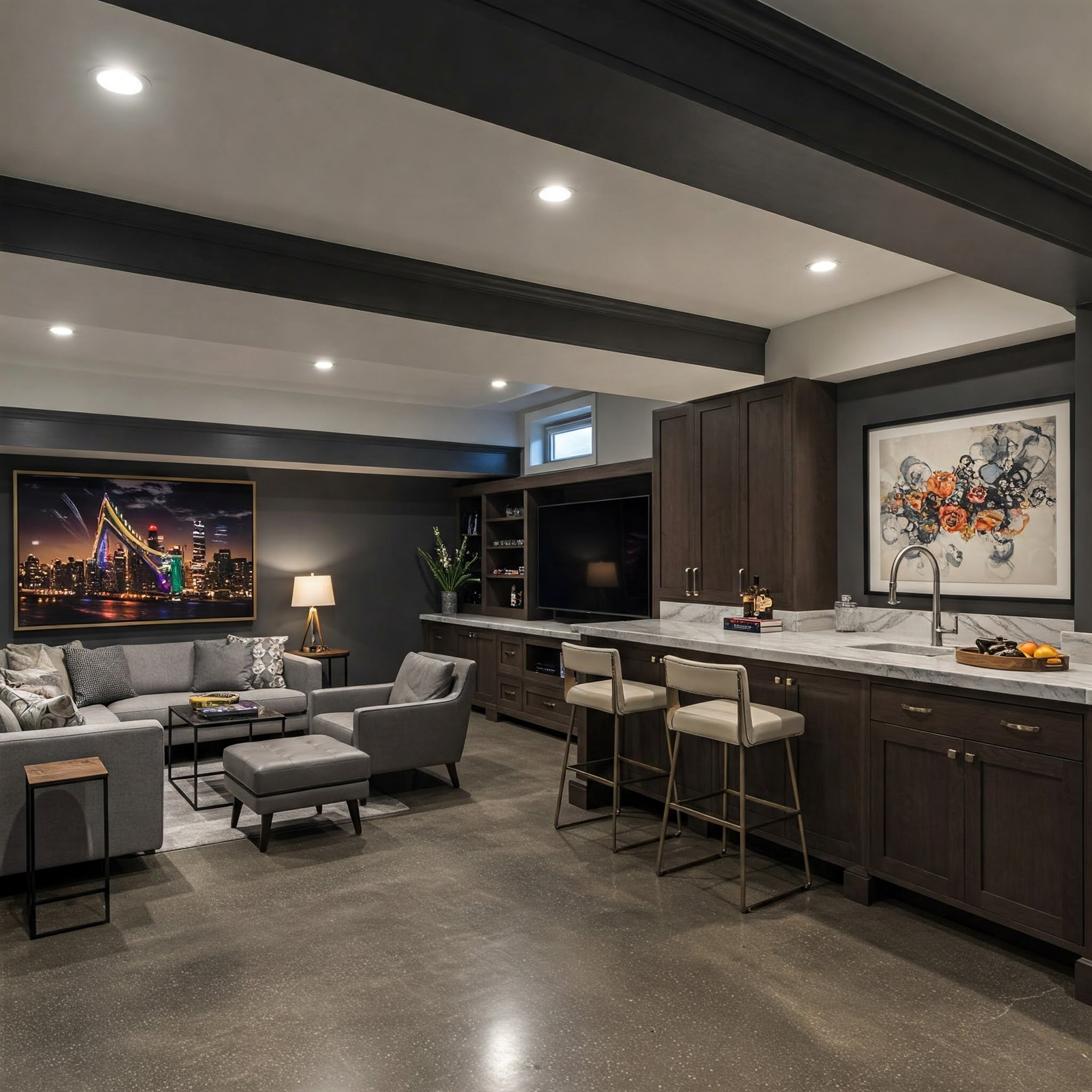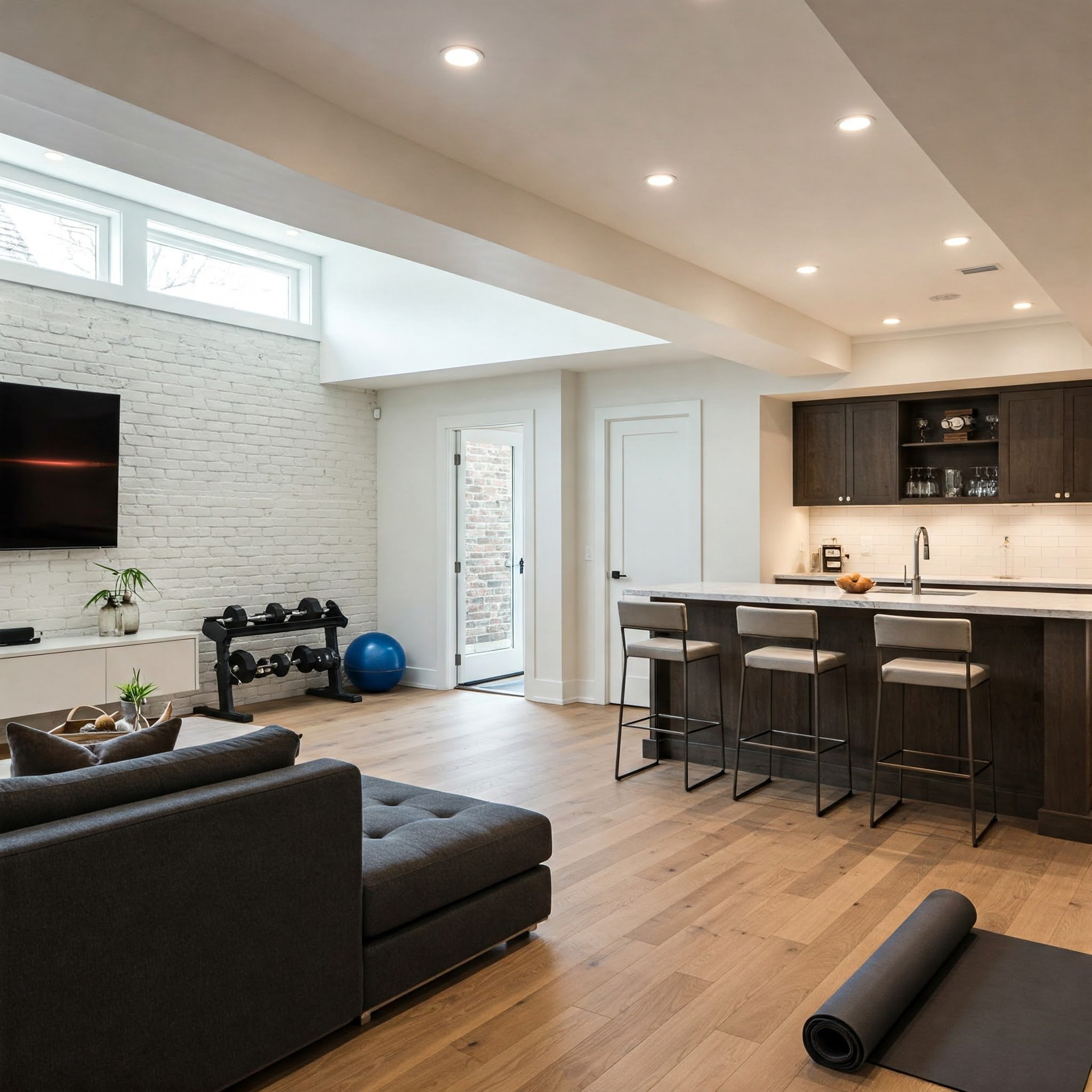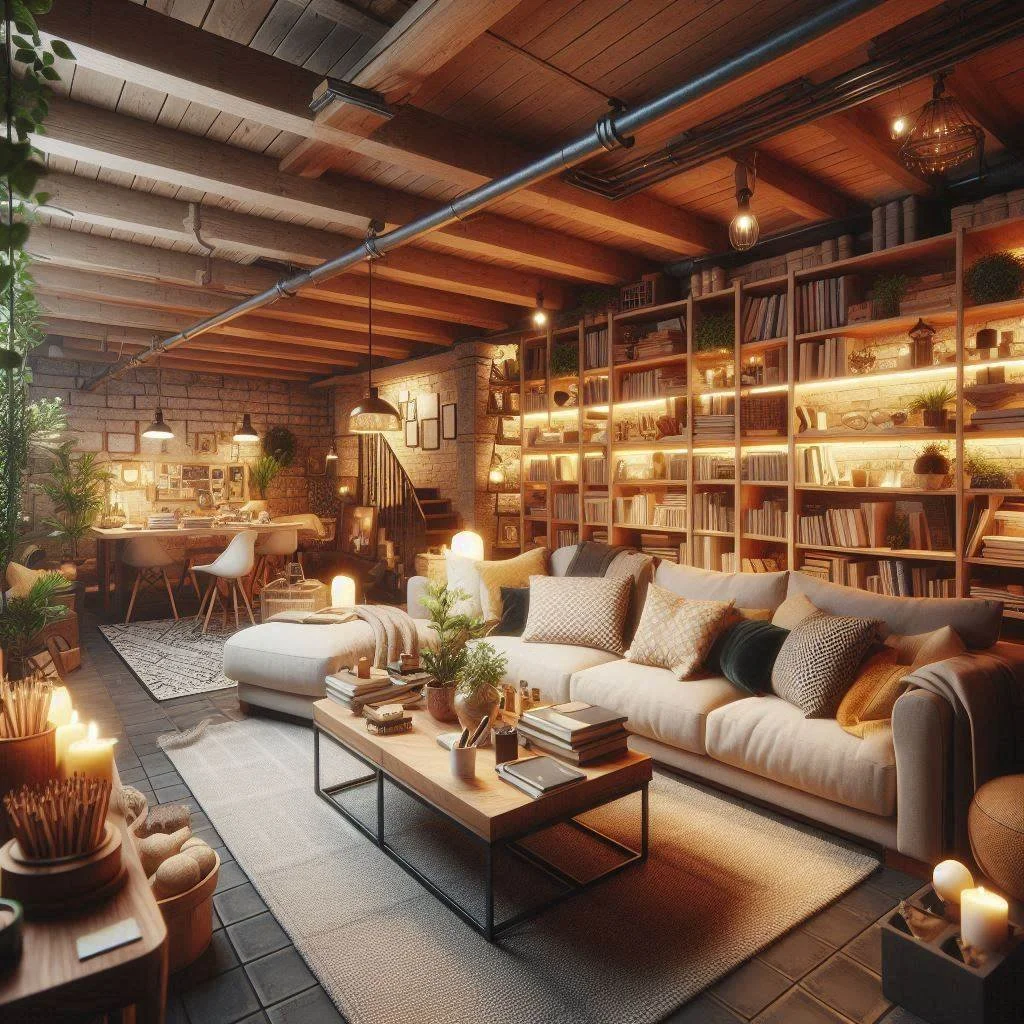How Much Does It Cost to Finish a Basement?
Wondering “How Much Does It Cost to Finish a Basement?” Explore factors affecting costs, design ideas, and money-saving tips for turning your unused below-ground space into a livable extension of your home.
Have you ever felt like your house is bursting at the seams—no matter how often you declutter? Or maybe you’ve dreamed of having a personal entertainment den, a guest suite, or a cozy home office but just can’t find the space upstairs? Well, hold onto your hat, because you might be sitting on a goldmine of untapped potential—literally beneath your feet. If you’re curious about expanding your living area without breaking the bank (or your back), you’ve probably asked that million-dollar question (not literally, we hope): How Much Does It Cost to Finish a Basement?
You’re in good company. Many homeowners see an unfinished basement as a blank canvas. Still, the price of turning those cold, concrete walls into a habitable space can vary wildly. From choosing a simple rec room to going all out with a home theater, the final tally depends on your personal style, local labor costs, and the complexity of the job. But don’t toss your dream aside—after reading this guide, you’ll have a firm understanding of all the nuts and bolts (and dollar signs) that go into finishing a basement.
How Much Does It Cost to Finish a Basement? The Big Picture
To get the ball rolling, let’s tackle the big question head-on: How Much Does It Cost to Finish a Basement? Well, there’s no straightforward one-size-fits-all answer, and that’s because your total investment can be shaped by so many factors—size, location, finishing materials, labor expenses, and even city permits.
While some homeowners might turn their basement into a cozy, no-frills hangout for a mere $10,000, others can drop $70,000 or more on a high-end, swanky retreat complete with a wet bar, plush carpeting, and top-of-the-line fixtures. Most folks will likely land somewhere in the middle: a well-finished, functional space for around $25,000 to $50,000. That’s a broad range, right? Well, hold your horses. We’ll sift through the layers to paint a clearer picture.
Key Cost Components
Below are the major cost areas you’ll want to pencil in if you’re pulling together a budget:
Design and Planning
Permits and Inspections
Structural Work
Utilities (Plumbing, Electrical, HVAC)
Insulation and Drywall
Flooring and Ceiling
Finishes (Paint, Trim, Décor)
Furniture and Extras
We’ll dive into each category in detail, so you can get a grip on where your money’s going and keep from being blindsided by hidden costs.
1. Design and Planning
So you’re itching to get started, but don’t go swinging a sledgehammer into your basement walls just yet. A well-thought-out plan can save you big bucks and a ton of headaches in the long run. You might hire an architect, interior designer, or at least consult a contractor experienced in basement finishing to ensure your space meets local building codes and is functional for how you plan to use it.
Why Does This Matter?
Efficiency: Having a plan helps keep you from running into “uh-oh” moments that require costly reworks.
Aesthetics: Pros can help you choose layouts, color schemes, and designs that maximize space and vibe.
Safety: Basements come with unique concerns like moisture, egress windows, and ventilation. A pro’s input is crucial for meeting safety requirements.
Cost Range
Architect or Designer: $2,000 - $5,000 (depending on complexity)
Contractor Consultations: Typically part of the overall estimate, but you might pay for an initial consult.
2. Permits and Inspections
Paperwork might feel like a snooze-fest, but it’s part and parcel of finishing a basement the right way. Depending on your municipality, you may need building, electrical, and plumbing permits. Plus, an inspector typically pops by at various stages to ensure you’re meeting local codes.
Why This Matters?
Legal Compliance: You’ll avoid fines and future hassles if you choose to sell.
Safety: Proper inspections help catch structural or code violations early.
Resale Value: Documented, permitted work often increases property value.
Cost Range
Permits: $500 - $2,000 (varies by region and scope)
Inspections: Often included in permit fees, but check your local guidelines.
3. Structural Work
Some basements are a breeze—four solid walls, a decent ceiling height, and no need for major foundation updates. Others require more heavy-duty tasks like reinforcing walls, adding support beams, or even digging deeper to create adequate headroom. This is where the cost can skyrocket if your basement is in rough shape or you’re planning significant structural changes.
Why This Matters?
Long-Term Stability: Nobody wants cracks in the foundation or sagging floors.
Moisture Control: Sealing walls and floors is crucial to prevent mold or water damage.
Height Requirements: If your ceiling’s too low, you might need to underpin or dig down (which is pricey).
Cost Range
Minor Repairs: $1,000 - $5,000
Major Overhauls: $10,000 - $30,000 or more
4. Utilities (Plumbing, Electrical, HVAC)
You can’t fully enjoy a basement if it’s colder than a witch’s broomstick in winter or hotter than a jalapeño in summer. And let’s not forget about lights, outlets, and possibly a bathroom. Cue the pros: electricians, plumbers, and HVAC specialists.
Electrical
Adding Circuits: If your current panel can handle the load, great; if not, you might need an upgrade.
Lighting: Recessed lights are popular for basements, but keep in mind fixtures, switches, and potential rewiring can add up.
Plumbing
Bathrooms: Installing a basement bath might require a grinder pump or specialized plumbing systems if your drainage lines sit above the basement floor.
Wet Bars: Even a small sink needs reliable hot and cold supply and proper drainage.
HVAC
Ductwork: Extending or adjusting existing ducts to maintain comfortable temperatures.
Ventilation: Basements can get stuffy, so proper airflow is crucial.
Cost Range
Electrical: $1,500 - $4,000
Plumbing: $1,000 - $10,000 (baths can be on the higher end)
HVAC: $1,000 - $5,000 or more, depending on complexity
5. Insulation and Drywall
You wouldn’t toss on a sweater without a jacket in winter—your basement’s no different. Insulation is vital to keep it warm in cold months and comfy in the summer. Once insulated, drywall typically covers the walls and ceilings, giving your basement that real “living space” feel.
Why This Matters?
Energy Efficiency: Proper insulation can reduce utility bills.
Comfort: No more stepping into what feels like an underground icebox.
Sound Control: Extra insulation can also dampen noise between floors.
Cost Range
Insulation: $1,000 - $3,000 (material and labor)
Drywall: $1,500 - $3,500 (for walls and ceilings)
6. Flooring and Ceiling Options
Gone are the days when basements were relegated to cold cement floors and exposed rafters overhead. Now you can choose from a variety of flooring and ceiling options that rival the aesthetic of your main living areas.
Flooring Choices
Carpet: Cozy underfoot and cost-effective, though it can hold moisture if your basement isn’t bone-dry.
Laminate: Popular for its affordability and versatility.
Vinyl Planks: Resilient to spills and relatively easy to install.
Engineered Hardwood: A higher-end choice with natural wood layers but can be sensitive to moisture.
Tile: Waterproof and durable, though it might feel cooler.
Ceiling Choices
Drywall: A polished look but tricky to access pipes or wiring overhead.
Drop Ceiling: Convenient if you need to get to hidden utilities later; however, less seamless in appearance.
Exposed Ceiling: An industrial-chic trend, but you’ll have to paint or treat the beams and pipes for a finished look.
Cost Range
Flooring: $2 - $10 per square foot, installed
Ceiling: $1 - $4 per square foot, installed
7. Finishes (Paint, Trim, and Décor)
Ever notice how a fresh coat of paint can transform a room from drab to fab in no time flat? The same principle applies to basements. This step includes everything from picking paint colors to installing baseboards, crown molding, lighting fixtures, and even built-in shelving.
Why This Matters?
Personal Touch: It’s where your basement’s personality really shines.
Coordination: Matching colors and trim styles with your existing home décor fosters a cohesive look.
Budget Control: While paint is relatively cheap, fancy woodwork and custom cabinets can put a dent in your wallet.
Cost Range
Paint: $300 - $800 for an average basement (DIY can save you more).
Trim and Décor: $500 - $5,000 (depending on materials and complexity)
8. Furniture and Extras
Finally, let’s talk about the icing on the cake. Whether you’re turning your basement into a home theater, a sleek office, a gym, or a game room, you’ll need the right furnishings and gadgets.
Possible Add-Ons
Home Theater Equipment: Projector, big-screen TV, surround sound system—these can add a hefty chunk of change.
Bar or Kitchenette: Cabinets, sink, mini-fridge, or even a full range if you’re going the in-law suite route.
Gym Equipment: Treadmills, free weights, or specialized flooring for yoga.
Gaming Tables: Pool table, ping-pong, or foosball for entertaining.
Cost Range
Furniture & Décor: $1,000 - $15,000+
Specialized Equipment: $500 - $20,000+ (home theater systems and upscale bars can climb high)
Money-Saving Tips: How to Keep Costs in Check
Let’s face it—renovation budgets can spiral faster than you can say “budget overrun.” If you’re looking to keep an eye on your wallet while finishing your basement, here are some suggestions:
Plan Thoroughly
Lay out your design and budget before buying a single 2x4. Spontaneous changes mid-project can cost more than a latte habit.
DIY Where Possible
Painting, installing some flooring types, or even hanging trim can be tackled by confident DIYers.
Shop Sales and Reuse
Check out clearance sales, thrift stores, or reclaim centers for doors, light fixtures, or even furniture.
Phase the Project
If your budget’s tight, finish the main living area first. Save the bar or bathroom for later, once you’ve refilled the piggy bank.
Set a Realistic Contingency
Renovations have a nasty habit of unveiling surprises. Set aside 10-20% of your budget for unexpected twists.
Real-World Cost Scenarios: How Much Does It Cost to Finish a Basement?
To bring this all together, let’s peek at a few hypothetical examples:
The Bare-Bones Retreat
What You Get: Insulated and drywalled walls, basic electrical, simple flooring (like laminate), a ceiling finish, and a coat of paint.
Estimated Cost: $15,000 - $25,000
Perfect For: Families looking for a no-frills rec room or play area on a modest budget.
The Mid-Range Marvel
What You Get: High-quality insulation, custom lighting, a small bathroom, vinyl plank flooring, and some built-in storage.
Estimated Cost: $30,000 - $50,000
Perfect For: Homeowners wanting a multi-use space—think a cozy lounge plus a place for overnight guests.
The Luxe Underground Oasis
What You Get: High-end finishes, a wet bar, media center with surround sound, plush carpet, decorative moldings, and maybe even a gas fireplace.
Estimated Cost: $60,000 - $100,000+
Perfect For: Those who view their basement as an extension of their main living area—entertainers, big families, or folks wanting to wow guests.
Conclusion
By now, you’re probably itching to roll up your sleeves and transform that cold, dingy basement into a space you’re proud to show off. And you’ve likely realized that answering the question, How Much Does It Cost to Finish a Basement?, is a bit like asking how long a piece of string is. The final number can swing wildly depending on your vision, the existing condition of your basement, and your region’s labor and material costs.
What’s crystal clear, though, is that a finished basement can offer you a precious opportunity to expand your home’s living space—without forking over a fortune on new construction. Whether you dream of a cozy family room, an in-law suite for out-of-town relatives, or a jaw-dropping entertainment haven, your basement might hold more potential than you ever imagined.
Just remember: measure twice (your budget and your basement), confirm your local permits and codes, then proceed with a plan in hand. Don’t skimp on essential tasks like waterproofing and insulation, and always brace for a few curveballs along the way. Once you’ve locked down the details, you’ll be well on your way to unlocking the hidden treasures beneath your floorboards
Read next: Basement Wall Repair: Effective Solutions and Costs
Frequently Asked Questions
1. Is finishing a basement really worth the cost?
You bet! Finishing a basement often adds valuable living space at a fraction of the cost of building an addition. It can boost your home’s resale value, provide a dedicated area for fun or relaxation, and potentially generate income if you convert it into a rental suite. Just be sure to do it the right way—permits and all—to avoid headaches down the line.
2. Do I need a permit to finish my basement?
Most likely, yes. The exact permits depend on your local building codes. Some municipalities require separate permits for electrical, plumbing, and structural changes. Even if your city doesn’t demand a permit, it’s wise to ensure you meet safety standards, especially if you’re adding bedrooms or bathrooms.
3. What about waterproofing?
Basements are notorious for moisture issues, so waterproofing is critical. That might include sealing foundation cracks, installing a sump pump, or adding a perimeter drain. While it’s an extra expense, it’s cheaper than dealing with mold remediation or ruined finishes later on.
4. Can I finish my basement myself?
If you’re pretty handy and understand local building codes, DIYing certain steps—like painting or installing flooring—can save you money. However, major tasks such as electrical, plumbing, and structural work typically require a pro’s expertise (and a permit!).
5. How long does it take to finish a basement?
If all goes smoothly, a straightforward basement project can take 2-3 months. More complex projects—especially those needing foundation work or custom designs—might stretch to 6 months or more. Factor in time for planning, permits, inspections, and those inevitable delays (back-ordered materials, for example).













